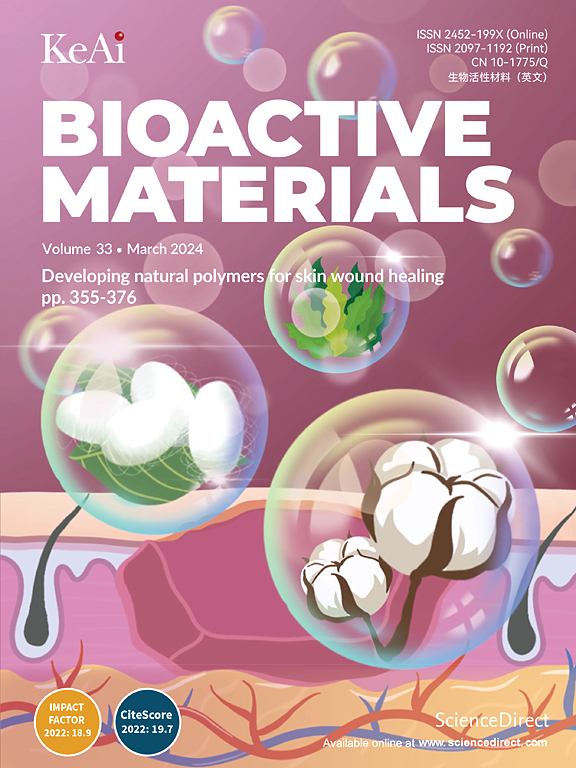Piezoelectric nanofilms fabricated by coaxial electrospun polycaprolactone/Barium titanate promote Achilles tendon regeneration by reducing IL-17A/NF-κB-mediated inflammation
IF 18
1区 医学
Q1 ENGINEERING, BIOMEDICAL
引用次数: 0
Abstract
Tendon injuries are often exacerbated by persistent inflammation, which hampers tissue regeneration. In this study, we developed a noninvasive, wirelessly controlled, and self-powered piezoelectric nanofilm fabricated by coaxial electrospinning of polycaprolactone (PCL) and tetragonal barium titanate nanoparticles (BTO), and investigated its roles in modulating inflammation and repairing Achilles tendon defects as well as the mechanism in a rat model. In vitro study and in vivo study upon subcutaneous implantation showed that the piezoelectric PCL/BTO nanofilms could inhibit M1 macrophage polarization and reduce the secretion of inflammatory factors. Moreover, when bridging an Achilles tendon defect, the nanofilms could promote tenogenic gene expression including collagen deposition, and collagen remodeling, facilitate functional tendon recovery and significantly reduce tissue inflammation by suppressing M1 macrophage polarization and promoting M2 polarization. Moreover, the piezoelectric stimulation could also enhance tendon regeneration by inhibiting angiogenesis, reducing lipid deposition, and decreasing ectopic ossification. Mechanistically, the piezoelectric nanofilms reduced tissue inflammation mainly via inhibiting the nuclear factor (NF)-κB signaling pathway that is mediated by interleukin (IL)-17A secreted from CD3+ T cells, and thus to reduce proinflammatory factors, such as IL-1β and IL-6, inducible nitric oxide synthase, monocyte chemoattractant protein-1, and tumor necrosis factor-α. These findings indicate the potential of piezoelectric stimulation in immunomodulation, and in promoting tendon regeneration via IL-17A/NF-κB-mediated pathway.

同轴静电纺丝聚己内酯/钛酸钡制备的压电纳米膜通过减少IL-17A/NF-κ b介导的炎症促进跟腱再生
肌腱损伤通常会因持续的炎症而加剧,这会阻碍组织再生。在这项研究中,我们开发了一种无创、无线控制、自供电的压电纳米膜,由聚己内酯(PCL)和四方钛酸钡纳米颗粒(BTO)同轴静电纺丝制成,并在大鼠模型中研究了其在调节炎症和修复跟腱缺陷中的作用及其机制。体外和皮下植入后的体内研究表明,压电型PCL/BTO纳米膜可以抑制M1巨噬细胞极化,减少炎症因子的分泌。此外,在跟腱缺损桥接时,纳米膜可通过抑制M1巨噬细胞极化和促进M2极化,促进胶原沉积和胶原重塑等致腱基因表达,促进肌腱功能恢复,显著减轻组织炎症。此外,压电刺激还可以通过抑制血管生成、减少脂质沉积和减少异位骨化来促进肌腱再生。压电纳米膜主要通过抑制CD3+ T细胞分泌的白细胞介素(IL)-17A介导的核因子(NF)-κB信号通路,从而降低促炎因子IL-1β、IL-6、诱导型一氧化氮合酶、单核细胞趋化蛋白-1、肿瘤坏死因子-α等。这些发现表明压电刺激在免疫调节方面的潜力,并通过IL-17A/NF-κ b介导的途径促进肌腱再生。
本文章由计算机程序翻译,如有差异,请以英文原文为准。
求助全文
约1分钟内获得全文
求助全文
来源期刊

Bioactive Materials
Biochemistry, Genetics and Molecular Biology-Biotechnology
CiteScore
28.00
自引率
6.30%
发文量
436
审稿时长
20 days
期刊介绍:
Bioactive Materials is a peer-reviewed research publication that focuses on advancements in bioactive materials. The journal accepts research papers, reviews, and rapid communications in the field of next-generation biomaterials that interact with cells, tissues, and organs in various living organisms.
The primary goal of Bioactive Materials is to promote the science and engineering of biomaterials that exhibit adaptiveness to the biological environment. These materials are specifically designed to stimulate or direct appropriate cell and tissue responses or regulate interactions with microorganisms.
The journal covers a wide range of bioactive materials, including those that are engineered or designed in terms of their physical form (e.g. particulate, fiber), topology (e.g. porosity, surface roughness), or dimensions (ranging from macro to nano-scales). Contributions are sought from the following categories of bioactive materials:
Bioactive metals and alloys
Bioactive inorganics: ceramics, glasses, and carbon-based materials
Bioactive polymers and gels
Bioactive materials derived from natural sources
Bioactive composites
These materials find applications in human and veterinary medicine, such as implants, tissue engineering scaffolds, cell/drug/gene carriers, as well as imaging and sensing devices.
 求助内容:
求助内容: 应助结果提醒方式:
应助结果提醒方式:


